“Infinity Number Two”: Scythe Mugen 2 Cooler Review

Cooling solutions often surprise testers. Sometimes, the surprise is a pleasant one, sometimes not. Today we are going to tell you about a solution like that. Learn from our today’s review what sort of surprise it brought us!
In my humble opinion, the Japanese Scythe Co., Ltd. is the leader among CPU cooling solution manufacturers. We arrived at this conclusion after estimating carefully the potential of Scythe’s main competitors. Take, for instance, Thermalright. Their coolers are of highest efficiency, but they are sold at very high prices. Besides, the evenness of their base plates leaves much to be desired, and the company could use a better developed dealer channel. The well-known Korean Zalman hasn’t offered much lately. They managed to score big in the beginning of this millennium, but have nothing but a known name left at this point. Thermaltake makes good coolers, which, however, come out pretty rarely. Even though we have to admit that the situation has been improving lately. ZEROtherm and the new ThermoLab are very rare guests in this market. Cooler Master seems to be the most dangerous Scythe’s competitor at this point, as this company offers not only cooling solutions with great price-to-efficiency ratio (Hyper TX 2, Hyper 212) but also expensive super-coolers, such as V8 and V10. Moreover, two more new cooling solutions from Cooler Master are coming out shortly. Besides, their coolers are very famous and spread world-wide. Have I missed anyone? Titan, ASUSTeK, Noctua and Xigmatek – these companies do not release new solutions that frequently and are not very well-known in the market. The only exception is Xigmatek: they make only cooling solutions with heatpipe direct-touch technology that doesn’t suit all contemporary processors.
Unlike competitors’ solutions, Scythe coolers are selling in all developed countries and stand out due to their very democratic pricing. The product range is quite diverse: starting with a compact and affordable Katana II and ending with an expensive gigantic Orochi. They update their product lineup with enviable regularity. Scythe announces new coolers every now and then. Among the already released new solutions, which we haven’t tested yet are Katana III (SCKTN-3000), REEVEN (RCCT-0901SP) or KILLER WHALE. Moreover, the company also offers a wide range of fans of different dimensions and applications as well as several other useful accessories. The only thing missing was one single cooler that could proudly bear the title of an absolute air-cooling leader. However, it turns out that Scythe closed this gap successfully with the just launched Mugen 2.

The first Infinity model appeared in the far away 2006. At that time Scythe Infinity cooler was recognized as one of the most efficient cooling solutions out there. Almost a year later, they launched second Infinity revision having changed its name to “Mugen”, which is the Japanese for “infinity”. At that time they only modified the fan (they installed a more high-performance and light-weight Slip Stream). Finally, in the beginning of 2009 Scythe launched a second revision of their Mugen cooler with a completely new heatsink design, new fan and different retention kit. But let’s start from the very beginning.
Package and Accessories
The new cooler sits in a compact cardboard box with a picture of itself on the front.
On this picture Scythe Mugen 2 is floating in space against the background of the planet Earth, which probably embodies the very concept of infinity. The other sides of the package are designed in the same manner. They also contain the list of cooler key features, technical specifications and bundled accessories.
Among these accessories you will find a universal backplate, retention kits with screws, SilMORE thermal compound, two wire clips for the fan and installation manual in six languages.
All components are secured reliably inside the box with cardboard inserts between them, which minimizes the risk of transportation damages.
Scythe Mugen 2 is made in Taiwan and is priced at $39.50.
Design and Functionality
The new cooler belongs to the tower type and measures 130 x 100 x 158 mm. Together with the fan it weighs 870g. This is what its heatsink looks like:
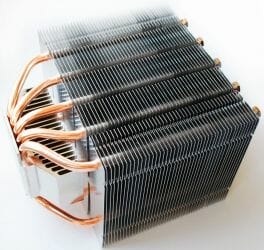
It consists of five independent arrays, each with its own 6mm heatpipe. So there are 5 heatpipes total. The heatsink arrays are spaced out equally and the gaps measure 2.8mm:
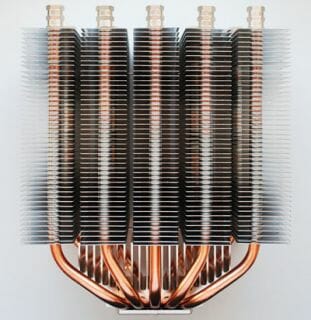
In fact, splitting the heatsink into 5 individual arrays is the key peculiarity of Scythe Mugen 2. Japanese engineers called this feature M.A.P.S. (Multiple Airflow Pass-through Structure). According to Scythe engineers, this “split” heatsink will not only improve heat dissipation from the parts of the heatsink around the heatpipes, but also increase the cooling efficiency of each individual heatsink array. They have also stressed that this stricture is best fit for Scythe Slip Stream 120 fans, one of which is bundled with Mugen 2.
Each heatsink array consists of 46 aluminum plates, each 0.35 mm thick that e spaced out at 2mm from one another:
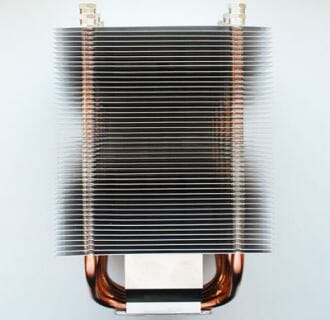
The three central arrays are narrower than the two outside ones. They measure 22mm and 25mm respectively:
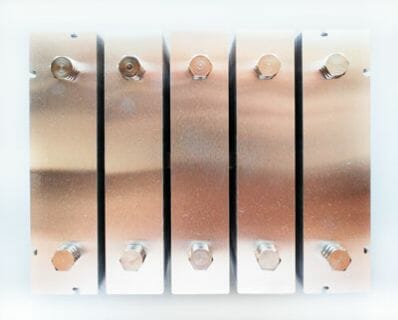
As for the length of the heatsink plates, it is the same for all arrays and measures 100mm. so, a simple mathematical calculation reveals that the total effective heat dissipating surface of the new Scythe Mugen 2 is 10,634cm2, which is almost 2,000cm2 bigger than that of the gigantic Scythe Orochi (8,702cm2), a little bigger than by a triple-heatsink Cooler Master V10 (10,569cm2) and is an absolute record among contemporary CPU coolers today.
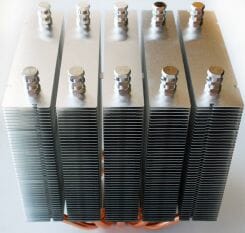
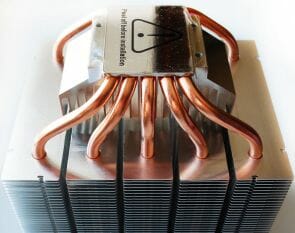
I have to add that the ends of all heatpipes are covered with decoratively shaped aluminum caps.
There is an additional aluminum heatsink array 80x40mm at the bottom of the main heatsink. It contacts the top of the heatpipes above the base:
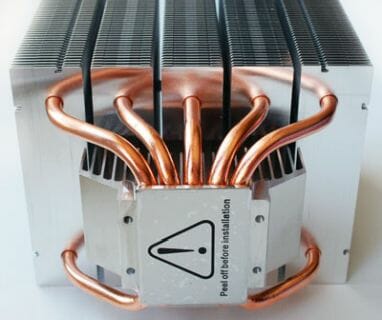
It’s most likely intended to take the heat away from the part of the heatpipes above the base plate that isn’t cooled in any way.
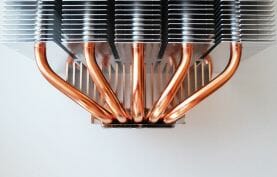
The heatpipes are glued to the base using thermal glue. There are no grooves in the base that we have been waiting for forever (by the way, there are grooves in the additional heatsink).
However, the nickel-plated copper base plate is finished exceptionally well. The base plate is very even. You can only see tiny imperfections at the very corners of it if you use a metal ruler.
Most importantly, the surface is impeccable where it contacts the processor heat-spreader. Scythe Mugen 2 is equipped with a 9-blade 120 x 120 x 25mm fan from Slip Stream 120 series (SY1225SL12LM-P model).
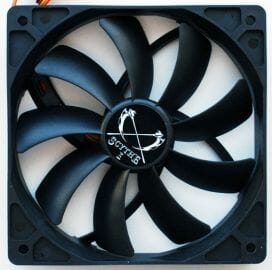
The fan uses a slide bearing with 30,000 hours MTBF (over 3 years of non-stop operation). The fan rotation speed is PWM controlled from 0 to 1300RPM creating up to 74.25CFM airflow. The maximum level of noise generated by the cooler fan is claimed to not exceed 26.5dBA.
Slip Stream 120 is attached to the heatsink with two wire clips. Their ends get inserted into exterior holes of the fan frame and then the clips click on to special notches on the heatsink.
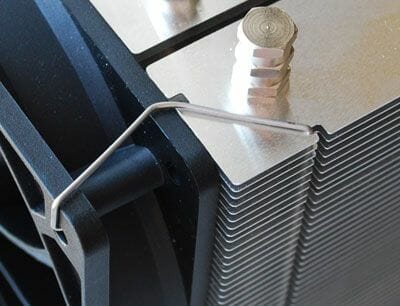
The heatsink has a total of 8 symmetrical notches, so you can attach up to four fans to it. In this case, however, you will need to get another 3 fans and three additional retention kits for them.
As you understand, you can install the enclosed fan either along one of the heatsink arrays or across them.
The cooling efficiency will be the highest if the airflow is directed along the arrays. The manufacturer recommends this particular installation, so the only situation when you may need to install the fan differently, is when you can’t attach the retention clips to one of the wide sides of the cooler for some reason.
Supported Platforms and Installation Tips
Scythe Mugen 2 can be installed on all contemporary platforms without any exceptions. It is compatible even with the outdated Socket 478 platform. You can download a detailed manual that will guide you through the installation procedure step by step. We are going to dwell only on the major milestones.
First of all you have to attach the retention corresponding to your processor socket type to the cooler base.
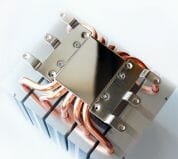
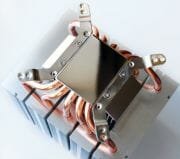
As you see, the new cooler is attached to the backplate through the mainboard PCB, so you will have to take the board out of the system case before installing the cooler. Scythe has finally given up the unreliable “push-pin” retention that used to bend the mainboard PCB. They equipped their flagship solution with excellent retention and a universal backplate.
Despite the seeming bulkiness, backplate fit just fine on the bottom of my DFI LANPARTY DK X48-T2RS mainboard:
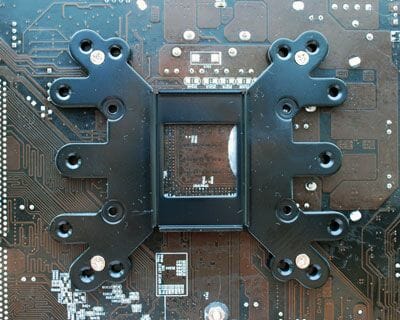
By the way, when the cooler is installed onto LGA1366 mainboards, you will have to remove the standard backplate they come equipped with and use the one from the Mugen 2 retention kit. They also included a special wrench with the cooler’s accessories that you will need to remove the default backplate.
The distance from the cooler base to the lower heatsink plate is 41mm. Besides, the cooler is very compact at the base, so the heatpipes and the additional heatsink didn’t cause any trouble during system assembly.
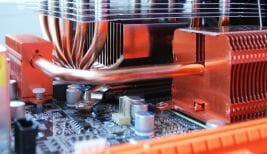
However, it turned out tricky to install the fan onto the heatsink. First, I had to remove a memory DIMM module from the first slot, because its tall heat-spreader wouldn’t let me put the fan in. And second, I failed to fasten one of the wire clips to the lower part of the heatsink, because it pushed against the memory chipset heatsink.
In fact, the latter is not really a big problem, because the top of the wire clip did get into the notch. As for the memory module, I would recommend potential Scythe Mugen 2 owners either to get DIMMs without heat-spreaders or to make sure that the cooler with a fan will not interfere with the memory modules featuring tall heat-spreaders on their board. Here I need to add that the distance from the center of the cooler to the edge of the wide heatsink is 50mm (add another 25mm for the fan).
No LEDs or any other decorative stuff. Everything is very strict and serious.
Testbed and Methods
We tested the new cooling system from Scythe and its competitor inside a closed system case. We didn’t perform any tests in an open testbed and will not do that anymore from now on, because we are using a new system case now – Antec Twelve Hundred. At low fan rotation speed we detected no difference whatsoever with the results obtained in an open testbed, and at high fan rotation speed the results in an open testbed were only 1-2°C lower. So, it doesn’t really make sense to take the testbed apart on a regular basis for the sake of this insignificant difference.
Our testbed was identical for all coolers throughout the test session and featured the following configuration:
- Mainboard: DFI LANPARTY DK X48-T2RS (Intel X48), LGA 775, BIOS 10/03/2008;
- Processor: Intel Core 2 Extreme QX9650 (3.0GHz, 1.25V, 2x6MB L2 cache, 4x333MHz FSB, Yorkfield, C0);
- Thermal interface: Arctic Silver 5;
- Graphics card: ZOTAC GeForce GTX 260 AMP2! Edition 896MB, 650/1400/2100MHz (1030RPM);
- Memory:
- 1 x 1024MB Corsair Dominator TWIN2X2048-9136C5D (Spec: 1142MHz / 5-5-5-18 / 2.1V);
- 2 x 1024MB CSX DIABLO CSXO-XAC-1200-2GB-KIT (Spec: 1200MHz / 5-5-5-16 / 2.4V);
- Disk subsystem: Western Digital VelociRaptor (SATA-II, 300GB storage capacity, 10,000RPM, 16MB cache, NCQ);
- HDD silencer and cooler: Scythe Quiet Drive 3.5”;
- Optical drive: Samsung SH-S183L;
- System case: Antec Twelve Hundred (default 120mm fans replaced with Scythe Slip Stream 120 fans at 800RPM; 120-mm Scythe Gentle Typhoon at 800RPM installed on the front of the case; standard 200-mm fan at 400RPM at the top of the case);
- Control and monitoring panel: Zalman ZM-MFC2;
- Power supply: Zalman ZM1000-HP 1000W (with a default 140 mm fan).
All tests were performed under Windows Vista Ultimate Edition x86 SP1. We used the following software during our test session:
- Real Temp 3.0 – to monitor the processor core temperature;
- RightMark CPU Clock Utility 2.35.0 – to control processor thermal throttling;
- Linpack 32-bit with LinX shell version 0.5.7 – to create maximum CPU load (two test cycles, 20 Linpack runs in each cycle with 1600 MB RAM capacity involved);
- RivaTuner 2.23 – to visually control temperature changes (with RTCore plugin).
The stabilization period for the CPU temperature between the two test cycles was 10 minutes. We took the maximum temperature of the hottest processor core of the four for the results charts.
The ambient temperature was checked next to the system case or open testbed with an electronic thermometer with 0.1°C precision that allows monitoring the temperature changes over the past 6 hours. During our test session room temperature stayed at 23.5-24°C.
Now let me say a few words about the today’s main competitor for Scythe Mugen 2. IT is going to be ThermoLab BARAM.
We tested this super-cooler with one and two Scythe Slip Stream 120 fans at speeds between 510 and 1860 RPM. Scythe Mugen 2 was tested with the same exact fans at the same rotation speeds, besides the tests with a default PWM-controlled fan.
Cooling Efficiency
During the Linpack test we managed to overclock our 45 nm quad-core processor to 3.8 GHz (+26.7%) at minimal fan rotation speed of 510RPM. The nominal processor Vcore was increased to ~1.5 V in the mainboard BIOS (+30.4%).
None of the today’s testing participants could cope with an overclocked processor with only one fan rotating at 510RPM that is why we are going to start our diagrams with the dual-fan mode at this speed:
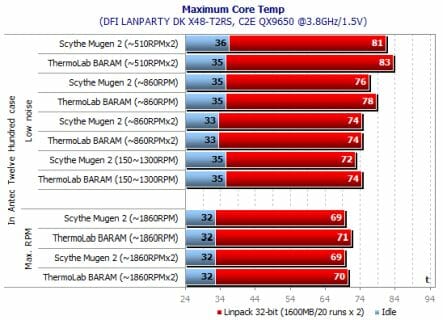
Here you go! Just a little while back ThermoLab BARAM managed to slightly outperform Thermalright Ultra-120 eXtreme. And today Scythe Mugen 2 won 2°C from BARAM. The cooling efficiency leader has changed one more time. Note what a great job they did on picking a fan for this cooler. Mugen 2 equipped with two fans at 860RPM cools the CPU 2°C worse than with one PWM-controlled fan at its maximum speed of 1300RPM. If you use an even more powerful fan at 1860RPM, you will win another 3°C, but the noise will be a little too loud. Adding a second powerful fan doesn’t bring any additional benefits.
“Second infinity” turned out more efficient than “airflow” during the maximum CPU overclocking tests, too.
If cooling efficiency leaders will be changing so quickly from now on winning a few extra degrees every time, they will evidently hit unprecedented heights in CPU cooling very soon.
Conclusion
When I get to writing the conclusion to my reviews, I usually start with listing the drawbacks of the reviewed solution and then get to their advantages. But today, I didn’t find any drawbacks about the new Scythe Mugen 2 cooler. I could complain that they didn’t include an additional pair of retention wire clips for the second fan into the accessories bundle, or that they used cheap and not very efficient SilMORE thermal interface, or that they didn’t make grooves in the cooler base… However, all the above mentioned things are negligible compared with the remarkable cooling efficiency, low noise during maximum CPU utilization and noiseless operation in regular mode, very low price compared against that of other super-coolers, full compatibility with all existing platforms, and finally popularity of Scythe solutions all over the world. If we try to compare Scythe Mugen 2 against ThermoLab BARAM from all these standpoints, the former leader will lose. However, I suggest that we make the final conclusions after a massive test session on the new Intel Core i7 (LGA 1366) platform that will be completed shortly.
In conclusion to our discussion of performance and features of the new Scythe Mugen 2 cooler, we decided to award it with our prestigious Editor’s Choice Title as the Today’s Best CPU Air-Cooler.